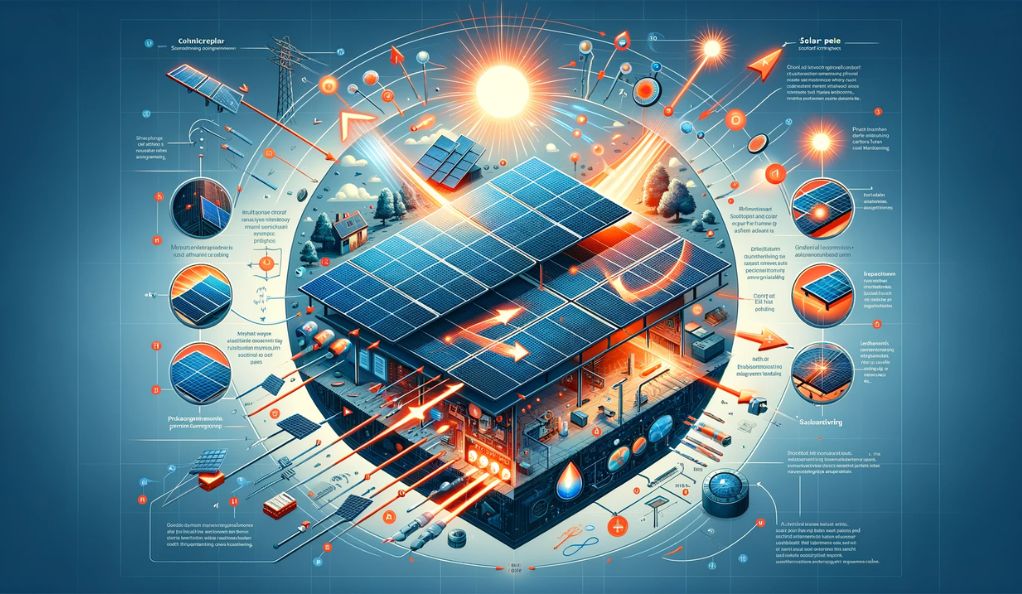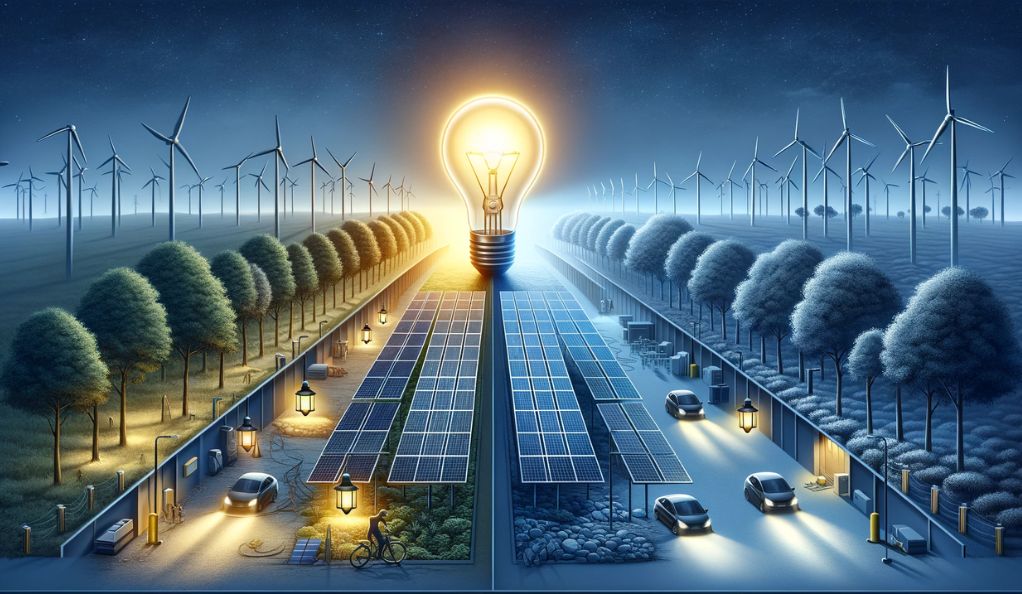Introduction
Solar power offers a promising path to clean and sustainable energy. Solar panels, also known as photovoltaic (PV) panels, capture sunlight and convert it into electricity, contributing to reduced bills and a greener planet. However, achieving optimal energy output from solar panels involves considering a critical but often underestimated factor: shading.
The efficiency of solar panels in converting sunlight into electricity plays a pivotal role in their performance. Higher efficiency leads to more power generation and cost-effectiveness. Shading, caused by objects like trees or buildings, can disrupt this efficiency by reducing sunlight exposure, leading to power loss, voltage mismatches, hotspots, and increased wear and tear on panels. In this article, we will explore the nuances of shading’s impact on solar panel performance, including types of shading, common sources, mitigation strategies, and the question of DIY solar panel installation. Let’s unlock the full potential of solar energy by understanding and addressing shading’s challenges and opportunities.
How Solar Panels Work

Understanding the inner workings of solar panels is crucial to grasp the impact of shading on their performance. Solar panels, often referred to as photovoltaic (PV) panels, are sophisticated devices designed to harness sunlight and convert it into electricity. To appreciate the effects of shading, let’s dive into the fundamental principles of how solar panels operate.
The Photovoltaic Process
At the heart of every solar panel is the photovoltaic effect. This process involves the conversion of sunlight into electricity through the interaction of photons (light particles) with semiconductor materials within the solar cells. Here’s how it works:
- Photon Absorption: When sunlight reaches the solar panel, its energy is absorbed by the semiconductor material, typically made of silicon. Each absorbed photon imparts energy to an electron within the material.
- Generation of Electron-Hole Pairs: The energy from absorbed photons elevates electrons to higher energy states, creating “electron-hole pairs.” These pairs are essentially unbound electrons and the holes they leave behind.
- Electron Flow: The presence of electron-hole pairs allows for the flow of electricity. Electrons migrate towards the front surface of the solar cell, creating an electrical current.
- Electricity Generation: The flow of electrons generates direct current (DC) electricity within the solar cell, which can then be converted into alternating current (AC) electricity, suitable for powering homes and businesses.
Solar Panel Components
To facilitate this photovoltaic process, solar panels consist of several essential components:
- Solar Cells: These are the individual units where the photovoltaic effect occurs. Solar cells are typically connected in series and parallel to form a solar panel.
- Glass Cover: The top layer of a solar panel is usually a protective glass cover that shields the cells from external elements while allowing sunlight to pass through.
- Anti-Reflective Coating: Some solar panels feature an anti-reflective coating on the glass to reduce light reflection and increase light absorption.
- EVA Encapsulation: A layer of ethylene-vinyl acetate (EVA) encapsulates the solar cells, providing protection and insulation.
- Backsheet: The backsheet is a weather-resistant layer on the rear side of the panel, preventing moisture ingress.
- Frame: Solar panels are often encased in a sturdy frame for structural support and ease of installation.
- Wiring: Electrical connections and wiring collect the generated electricity from the solar cells and channel it to the output.
Understanding these components and the photovoltaic process is vital as it enables us to appreciate how shading can disrupt this intricate system.
Understanding Shading
Shading plays a pivotal role in the performance of solar panels, and comprehending its intricacies is essential for anyone considering solar energy. Shading occurs when objects or obstructions partially or completely block sunlight from reaching the solar panels.
Types of Shading: Partial vs. Complete
Shading can be broadly categorized into two types: partial shading and complete shading.
Partial Shading
This occurs when only a portion of the solar panel is obstructed by shade. For example, a tree branch casting a shadow on part of the panel or a neighboring building partially blocking sunlight. Surprisingly, even minimal shading on a small section of a solar panel can disproportionately affect its overall performance.
Complete Shading
In this scenario, an entire solar panel is completely shaded, either by a large object or during certain times of the day when the panel is entirely in shadow. Complete shading results in a severe drop in electricity production from the affected panel.
Common Sources of Shading
Shading can emanate from various sources, and it’s crucial to identify potential shading factors when planning a solar installation:
- Trees and Foliage: Overhanging branches, leaves, and trees can cast shadows on solar panels as the sun moves across the sky. This natural shading can be seasonal and dynamic.
- Buildings and Structures: Nearby buildings, chimneys, or tall structures can cast shadows on solar panels, especially during the morning or late afternoon when the sun is low on the horizon.
- Dust and Dirt: Accumulation of dirt, dust, or debris on the surface of solar panels can create shading effects and reduce their efficiency.
- Cloud Cover: While not a permanent source of shading, passing clouds can intermittently block sunlight and affect solar panel output.
- Tilt and Tracking: In some cases, the orientation and tilt of solar panels themselves can cause self-shading as one panel blocks sunlight from reaching another.
Seasonal and Daily Shading Variations
The impact of shading is not static; it varies with the time of day and the season. Understanding these variations is essential for accurate energy production predictions. Shading patterns change as the sun’s position in the sky shifts throughout the day and as the seasons change. Proper planning and shading analysis tools are crucial to account for these variations and optimize solar panel performance.
Mitigating Shading Effects

Understanding the impact of shading on solar panels is just the beginning. To maximize your solar energy production, it’s essential to implement strategies to mitigate the adverse effects of shading.
Proper Solar Panel Placement and Orientation
Proper solar panel placement and orientation are essential strategies for mitigating shading’s impact. This involves calculating the optimal tilt and direction for your solar panels based on your location’s latitude and shading patterns. Adequate spacing between panels to reduce self-shading should also be considered. Additionally, during the planning phase, it’s crucial to identify and avoid potential shading sources such as nearby trees or tall buildings. Adjusting the panel layout accordingly can help minimize shading’s adverse effects.
Shading Analysis Tools and Technology
Advancements in technology have led to the development of shading analysis tools that can predict shading patterns throughout the year. These tools use data on your location, panel placement, and shading sources to simulate shading scenarios. By utilizing such tools, you can gain insights into when and where shading will occur, allowing you to make informed decisions about panel placement and orientation. Furthermore, you can adjust the arrangement of solar panels to minimize shading’s impact based on the analysis results and estimate the potential efficiency loss due to shading.
Innovative Solutions
Innovative solutions can also be employed to mitigate shading effects:
Solar Panel Tilting Systems
Some solar installations incorporate tilting systems that adjust the panel’s angle throughout the day to maximize sunlight exposure. These systems are particularly useful in locations with dynamic shading patterns.
Solar Tracking Systems
Solar tracking systems follow the sun’s path, ensuring panels are always oriented for maximum exposure. While effective, they tend to be more complex and costly.
Micro-Inverters and Power Optimizers
Micro-inverters and power optimizers can mitigate the impact of shading at the panel level. They optimize the power output of individual panels, allowing shaded panels to operate independently of the rest of the array.
Bypass Diodes
Panels equipped with bypass diodes can mitigate shading effects by redirecting current around shaded cells, preventing power loss.
DIY vs. Professional Installation
The decision to install solar panels yourself or hire professionals is a crucial consideration when embarking on your solar energy journey. Both approaches have their pros and cons, and understanding them can help you make an informed choice that aligns with your goals and resources.
The Pros and Cons of DIY Solar Panel Installation
Pros:
- Cost Savings: DIY installation can save you money on labor costs. You have the option to purchase solar panel kits and handle the installation yourself.
- Educational Experience: Installing solar panels yourself can be a valuable learning opportunity, providing hands-on experience with solar technology.
- Customization: DIY allows you to customize your solar panel system to your specific needs and preferences.
Cons:
- Complexity: Solar panel installation can be complex and technically demanding, requiring electrical and roofing skills. Mistakes can lead to safety hazards and reduced efficiency.
- Safety Risks: Working with electrical components and climbing on roofs poses safety risks. Professional installers are trained to handle these challenges safely.
- Regulatory Compliance: DIY installers must navigate local building codes, permits, and utility regulations, which can be a time-consuming and daunting task.
The Benefits of Professional Installation
Pros:
- Expertise: Professional installers are experienced and trained to handle all aspects of solar panel installation, ensuring optimal performance and safety.
- Efficiency: Professionals can complete the installation faster and more efficiently, minimizing downtime and disruptions.
- Warranty and Support: Many professional installations come with warranties and ongoing support, providing peace of mind.
Cons:
- Cost: Professional installation typically comes at a higher initial cost due to labor expenses. However, this cost may be offset by increased efficiency and fewer complications.
- Less Hands-On Experience: If you’re interested in learning about solar technology through hands-on experience, professional installation may not provide that opportunity.
Cost Comparison and Return on Investment
When deciding between DIY and professional installation, it’s essential to consider the overall cost and long-term return on investment (ROI). While DIY may seem cost-effective upfront, it can lead to higher expenses if mistakes are made or if the system underperforms due to installation issues.
Professional installations often come with warranties and guarantees, ensuring that the system operates efficiently and performs as expected. Additionally, professionals can help you navigate complex regulations, secure permits, and access available incentives and rebates.
Ultimately, the choice between DIY and professional installation depends on your expertise, available time, budget, and your willingness to take on the responsibilities and risks associated with DIY solar panel installation.
Conclusion
In the quest to harness the full potential of solar energy, understanding the intricate relationship between shading and solar panel performance is paramount. Shading, whether partial or complete, from trees, buildings, or self-shading, can significantly affect energy production. However, by implementing proper placement and orientation techniques, utilizing shading analysis tools, and exploring innovative solutions, the impact of shading can be mitigated effectively. The decision of whether to embark on a DIY solar panel installation journey or seek professional expertise should be made with careful consideration of individual skills, resources, and goals. Real-world case studies further emphasize the importance of these strategies in maximizing energy output and return on investment. As we journey towards a greener future, addressing shading challenges plays a pivotal role in optimizing the benefits of solar energy.
